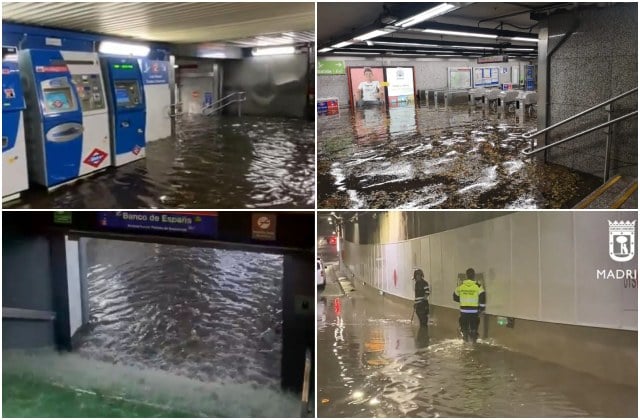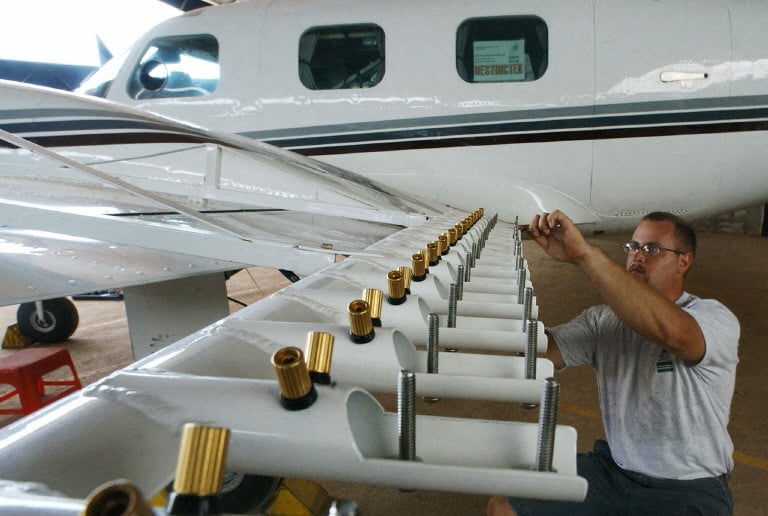The torrential rains affecting large parts of Spain this week have reached Madrid and flooded its metro system, causing the closure of several lines.
Though Spain may not have had the snowfall that much of northern Europe currently has, central and southern areas of the country have experienced heavy rains, very strong winds and flooding.
The arrival of Storm Efraín has brought adverse weather to 35 provinces that have been on alert. In some parts of the country, it hasn’t stopped raining for over a week.
That’s been the case in Madrid, where heavy rain on Tuesday and Wednesday has seen Spanish social media fill up with images and videos of the capital’s metro system completely flooded by the heavy rainfall.
The steps of Quevedo station, in Madrid’s Trafalgar neighbourhood, were like a river on Wednesday night with a constant stream of rainwater rushing into the station.
#quevedo#metromadrid#lluvia pic.twitter.com/RjZFapAuFD
— Natalia Arroyo (@Naatarroyo) December 14, 2022
The Banco de España station, close to the famous Paseo del Prado in central Madrid, has been completely flooded and is closed.
La estación de metro de Banco de España, entre otras, cerrada por acumulación de agua. #Tormenta #Madrid #FMA Vídeo de @crehpo_ pic.twitter.com/p35MqaOXrc
— MeteoMadrid (@carlosweder_) December 14, 2022
Emergency services across the Madrid region responded to 323 incidents related to flooding including the metro stations, disrupted traffic, fallen trees and damage to homes and buildings.
One Madrileño saw the funny side of things however, joking that ‘they say Madrid doesn’t have a beach’, and adding ‘Point of View: You forgot your bikini’.
un miércoles en madrid sur. Para que luego digan que Madrid no tiene playa… #lluvia #lluviamadrid #madrid #metro #metrosur #metrolluvia #linea12 pic.twitter.com/uwt6VoR1qy
— SYMATEC (@SYMATEC1) December 15, 2022
Footage shared on Twitter also shows the Puerta del Sol station inundated with rainwater, described as a ‘wasteland’.
Madrid se nos inunda y la lluvia no ha sido tanta…
Las zonas recientemente reordenadas por el Ayuntamiento,sin capacidad de drenar. La Puerta del Sol, todo adoquines, un erial.
Como nos están dejando Madrid… pic.twitter.com/B6O1neRPMs— Ana Rosa Encinas (@AnaRosaEncinas1) December 15, 2022
The flooding has caused partial or full closures on Madrid Metro lines 2, 4, 5, 6, 7 and 11.
Commuters who still tried to use the metro have been faced with rainwater working its way all the way down to the platform, and even leaking into the train carriages, as seen here.
Lo que está pasando en Madrid con la lluvia necesita explicaciones urgentes.
Atención: pic.twitter.com/coirVduEav
— Más Madrid Ciudad (@MasMadridCiudad) December 14, 2022
More footage shared online shows that many Madrid streets have also been flooded, with some tunnels and roads being completely blocked off for cars, causing traffic jams in the process.
Madrid se vuelve navegable por unos días. ¡Que manera de llover! Buenas noches
📷 @Guigurui #Madrid #lluvia #granviamadrid pic.twitter.com/t7au3Q8RUk— 𝗚𝗿𝗮𝗻 𝗩í𝗮 𝗱𝗲 𝗠𝗮𝗱𝗿𝗶𝗱 (@Granviademadrid) December 14, 2022
Opposition party Más Madrid has compiled a video with all the most eye-catching footage of the floods in order to criticise right-wing city officials for not having the right drainage installed across the city to avoid Madrid grinding to a halt whenever there is heavy rain or snow.
Ayuso y Almeida no son responsables de las lluvias. Pero sí del abandono de las infraestructuras.
Llueve sobre mojado en Madrid y va siendo hora de cambio. pic.twitter.com/IDqCNx33Q5
— Más Madrid (@MasMadrid__) December 14, 2022
But even in rural areas of the Madrid region where tarmac and drainage can’t be blamed for the flooding, stair rods of rain came down on Wednesday, as in La Pedriza area of the Guadarrama mountain range where Madrid’s Manzanares river runs through.
No cabe más agua en La Pedriza y así es como baja el Manzanares a la altura de Cantocochino pic.twitter.com/70rBj5G4PA
— Parque Nacional de la Sierra de Guadarrama (@PN_Guadarrama) December 14, 2022
According to Spain’s Aemet weather agency, it will continue raining on Thursday and Friday in Madrid, with some respite over the weekend but more rain forecast for next week.




 Please whitelist us to continue reading.
Please whitelist us to continue reading.
Member comments